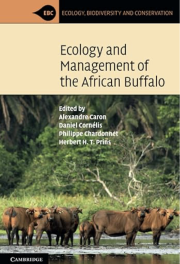Ecology and Management of the African Buffalo

Edited by Alexandre Caron, Daniel Cornélis, Philippe Chardonnet & Herbert H.T. Prins
Cambridge University Press, £39.99
Along with the African elephant, leopard, lion and black rhinoceros, the buffalo, Syncerus caffer, makes up one of the ‘big five’ for tourists, so its management is of great economic, ecological and social interest. It is also a natural resource, providing meat and other products as well as being of interest to researchers for its role in zoonoses as it is a host for many pathogens and parasites. The study of this species even has its own name: Nyatology or the science of the African buffalo.
As the foreword states ‘this book provides us with the most up-to-date story of what is known and not known of the wild species and how it may be managed for the benefit of humans.’ Divided into five main sections, part one covers conservation and evolution. This is followed by sections on ecology and diseases. The two final sections discuss management, including hunting and the future of the African buffalo.
Some of the newer information includes confirmation of three sub-species, including a dwarf forest type. It is also now known that buffalo populations, in general, are decreasing. Other new information relates to disease, particularly mutual disease transmission between buffalo and cattle. The complexity of the buffalo’s conservation status is highlighted and this appears to be due to the varied and vast ranges covered by the buffalo. In some areas, hunting may be desirable, in others, the animals may need protection. Hence the need for this volume and the very informative contributions of specialists, or nyatiologists.
Throughout, the editors, themselves active researchers, have done a professional job in organising the articles and maintaining a common format, including textual clarity and referencing. The contributors are truly international, coming from institutions in Africa, Australasia, Europe and the USA, as well as from IUCN specialist groups. Coloured maps and photographs enhance the text appropriately. Some photos, such as those showing putrefactive swellings and ulcers are not pretty, but serve a purpose.
Likely to appeal to anyone working with African wildlife, ecology or mammals, this book would also be of enormous value to anyone involved with wildlife management and of course, to specialists in African ungulates and bovines.
Dr Sue Howarth FRSB
Note: this title is also available as Open Access via Cambridge Core.
Reviewed by Dr Sue Howarth FRSB


